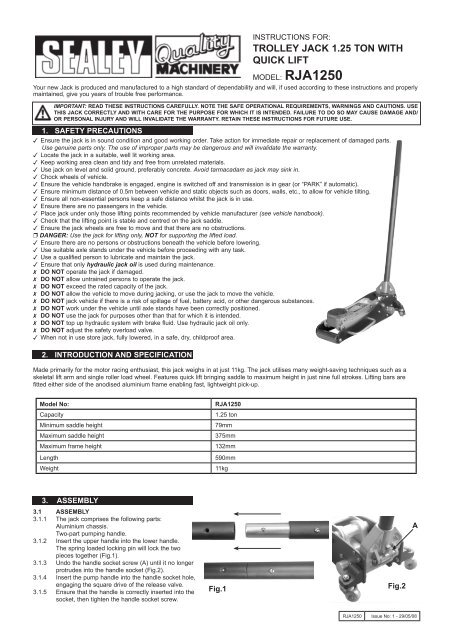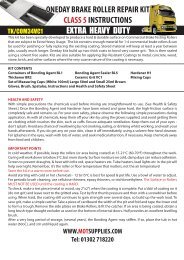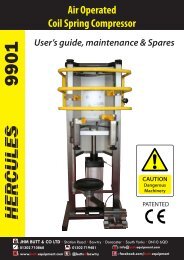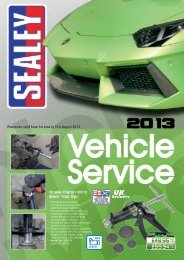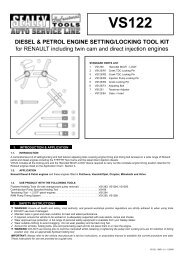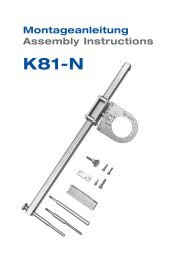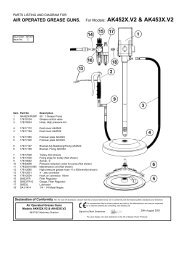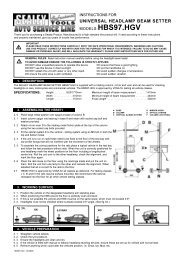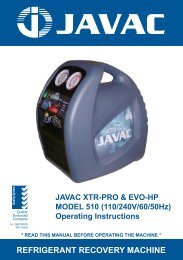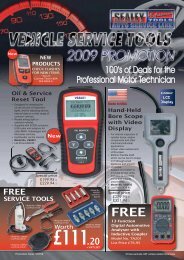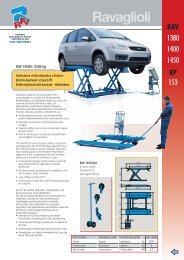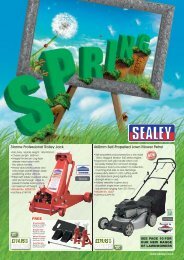TROLLEY JACK 1.25 TON WITH QUICK LIFT
TROLLEY JACK 1.25 TON WITH QUICK LIFT
TROLLEY JACK 1.25 TON WITH QUICK LIFT
Create successful ePaper yourself
Turn your PDF publications into a flip-book with our unique Google optimized e-Paper software.
Instructions for:<br />
<strong>TROLLEY</strong> <strong>JACK</strong> <strong>1.25</strong> <strong>TON</strong> <strong>WITH</strong><br />
<strong>QUICK</strong> <strong>LIFT</strong><br />
MODel: RJA1250<br />
Your new Jack is produced and manufactured to a high standard of dependability and will, if used according to these instructions and properly<br />
maintained, give you years of trouble free performance.<br />
Important: Read these instructions carefully. Note THE SAFE OPERATIONAL REQUIREMENTS, WARNINGS AND CAUTIONS. USE<br />
THIS Jack CORRECTLY AND <strong>WITH</strong> CARE FOR THE PURPOSE FOR WHICH IT IS INTENDED. failure to do so may cause damage AND/<br />
or personal injury and will invalidate the warranty. retain THESE INSTRUCTIONS for future use.<br />
1. SAFETY PRECAUTIONS<br />
Ensure the jack is in sound condition and good working order. Take action for immediate repair or replacement of damaged parts.<br />
Use genuine parts only. The use of improper parts may be dangerous and will invalidate the warranty.<br />
Locate the jack in a suitable, well lit working area.<br />
Keep working area clean and tidy and free from unrelated materials.<br />
Use jack on level and solid ground, preferably concrete. Avoid tarmacadam as jack may sink in.<br />
Chock wheels of vehicle.<br />
Ensure the vehicle handbrake is engaged, engine is switched off and transmission is in gear (or “PARK” if automatic).<br />
Ensure minimum distance of 0.5m between vehicle and static objects such as doors, walls, etc., to allow for vehicle tilting.<br />
Ensure all non-essential persons keep a safe distance whilst the jack is in use.<br />
Ensure there are no passengers in the vehicle.<br />
Place jack under only those lifting points recommended by vehicle manufacturer (see vehicle handbook).<br />
Check that the lifting point is stable and centred on the jack saddle.<br />
Ensure the jack wheels are free to move and that there are no obstructions.<br />
DANGER: Use the jack for lifting only, NOT for supporting the lifted load.<br />
Ensure there are no persons or obstructions beneath the vehicle before lowering.<br />
Use suitable axle stands under the vehicle before proceeding with any task.<br />
Use a qualified person to lubricate and maintain the jack.<br />
Ensure that only hydraulic jack oil is used during maintenance.<br />
DO NOT operate the jack if damaged.<br />
DO NOT allow untrained persons to operate the jack.<br />
DO NOT exceed the rated capacity of the jack.<br />
DO NOT allow the vehicle to move during jacking, or use the jack to move the vehicle.<br />
DO NOT jack vehicle if there is a risk of spillage of fuel, battery acid, or other dangerous substances.<br />
DO NOT work under the vehicle until axle stands have been correctly positioned.<br />
DO NOT use the jack for purposes other than that for which it is intended.<br />
DO NOT top up hydraulic system with brake fluid. Use hydraulic jack oil only.<br />
DO NOT adjust the safety overload valve.<br />
When not in use store jack, fully lowered, in a safe, dry, childproof area.<br />
2. INTRODUCTION AND SPECIFICATION<br />
Made primarily for the motor racing enthusiast, this jack weighs in at just 11kg. The jack utilises many weight-saving techniques such as a<br />
skeletal lift arm and single roller load wheel. Features quick lift bringing saddle to maximum height in just nine full strokes. Lifting bars are<br />
fitted either side of the anodised aluminium frame enabling fast, lightweight pick-up.<br />
Model No:<br />
Capacity<br />
Minimum saddle height<br />
Maximum saddle height<br />
Maximum frame height<br />
Length<br />
Weight<br />
RJA1250<br />
<strong>1.25</strong> ton<br />
79mm<br />
375mm<br />
132mm<br />
590mm<br />
11kg<br />
3. ASSEMBLY<br />
3.1 ASSEMBLY<br />
3.1.1 The jack comprises the following parts:<br />
Aluminium chassis.<br />
Two-part pumping handle.<br />
3.1.2 Insert the upper handle into the lower handle.<br />
The spring loaded locking pin will lock the two<br />
pieces together (Fig.1).<br />
3.1.3 Undo the handle socket screw (A) until it no longer<br />
protrudes into the handle socket (Fig.2).<br />
3.1.4 Insert the pump handle into the handle socket hole,<br />
engaging the square drive of the release valve.<br />
3.1.5 Ensure that the handle is correctly inserted into the<br />
socket, then tighten the handle socket screw.<br />
Fig.1<br />
Fig.2<br />
A<br />
RJA1250 Issue No: 1 - 29/05/08
4. AIR SYSTEM PURGING<br />
4.1 Open the release valve by turning it one full turn counterclockwise.<br />
4.2 Pump the handle eight full strokes.<br />
4.3 Close the release valve by turning it clockwise.<br />
5. OPERATING INSTRUCTIONS<br />
WARNING! Before use ensure you have read, understood and apply Section 1<br />
safety instructions.<br />
IMPORTANT: Before use, the operator is to visually inspect the jack for cracked<br />
welds, damaged or missing parts or hydraulic leaks.<br />
5.1 Raising a Vehicle<br />
5.1.1 Ensure that the jack and the vehicle are on a hard, level surface.<br />
5.1.2 Always ensure that the vehicle handbrake is engaged and that the vehicle wheels<br />
are chocked.<br />
5.1.3 Consult the vehicle manual to determine the location of jacking points. Position the<br />
jack under a suitable lifting point.<br />
5.1.4 Turn the release valve clockwise, to the closed position (Fig.3). DO NOT over<br />
tighten.<br />
5.1.5 Raise the vehicle to the designed height by pumping the handle up and down.<br />
5.1.6 Place axle stands beneath the locations recommended by the vehicle<br />
manufacturer.<br />
5.1.7 Turn the release valve slowly counterclockwise to lower the vehicle on to the axle<br />
stands.<br />
5.2 Lowering a Vehicle<br />
5.2.1 Turn the release valve clockwise to the closed position.<br />
5.2.2 Pump the handle to raise the vehicle off the axle stands.<br />
5.2.3 Remove the axle stands from beneath the vehicle.<br />
5.2.4 Turn the release valve slowly counterclockwise to lower the vehicle to the ground.<br />
NOTE: When not in use, ALWAYS leave the saddle and ram fully retracted.<br />
6. MAINTENANCE<br />
Fig.3<br />
A<br />
Fig.4<br />
IMPORTANT: Only fully qualified personnel should attempt maintenance or repair.<br />
6.1 Monthly Maintenance<br />
Lubrication is critical to jacks, since they support heavy loads. Any restriction due to dirt or rust can cause either slow jack movement,<br />
or extremely rapid jerks, causing damage to the internal components. To keep the jack well lubricated, carry out the following steps.<br />
6.1.1 Lubricate the ram, the linkages and the saddle and pump mechanism with light oil.<br />
6.1.2 Grease the wheel bearing and axles.<br />
6.1.3 Keep all jack surfaces and warning labels clean.<br />
6.1.4 Check and maintain the ram oil level (Section 6.3).<br />
6.2 Three Monthly Maintenance<br />
6.2.1 At three monthly intervals, check the ram for any signs of rust or corrosion. Clean the ram as required and wipe with an oil cloth.<br />
6.3 Checking the Oil Level<br />
6.3.1 Fully retract the ram by turning the release valve counterclockwise.<br />
6.3.2 With the jack in the level position, remove the oil filler plug (Fig.4.A).<br />
6.3.3 The oil should be level with the bottom of the oil filler hole. If it is not top up with clean hydraulic jack oil.<br />
6.3.4 Replace the oil filler plug and check the jack operation.<br />
6.3.5 Purge air from the jacking system as required. Refer to Section 4.<br />
NOTE: Always store the jack in the fully lowered position. This will protect critical areas from excessive corrosion.<br />
IMPORTANT: NO RESPONSIBILITY IS ACCEPTED FOR INCORRECT USE OF THis product.<br />
Hydraulic products are only repaired by local service agents. We have service/repair agents in all parts of the UK.<br />
DO NOT return jacks to us.<br />
Please telephone us on 01284 757500 to obtain the address and phone number of your local agent. If jack is under guarantee you can also<br />
contact your local dealer.<br />
De-commissioning the Jack<br />
Should the jack become completely unserviceable and require disposal, draw off the oil into an approved container and dispose of the jack<br />
and the oil according to local regulations.<br />
7. TROUBLESHOOTING<br />
PROBLEM CAUSE REMEDY<br />
Jack will not lift to full height Oil level low Check / top up oil level.<br />
Jack will not hold the load Release valve not closing Call for customer service<br />
Hydraulic jack oil is contaminated<br />
Pump valves not sealing<br />
Lift arm will not lower Cylinder ram binding Call for customer service<br />
Parts worn<br />
Internal component damage<br />
Broken or unhooked return spring<br />
Lift arm linkage either bent or binding<br />
Jack feels spongy when lifting System requires purging Refer to air purge procedure at Section 3<br />
RJA1250 Issue No: 1 - 29/05/08
8. DECLARATION OF CONFORMITY<br />
Declaration of Conformity We, the sole importer into the UK, declare that the product listed below is in conformity with the following<br />
standards and directives.<br />
Trolley Jack <strong>1.25</strong> Ton<br />
With Quick Lift<br />
Model: RJA1250<br />
93/68/EEC CE Marking Directive<br />
2006/42/EC Machinery Directive<br />
The construction file for this product is held by the Manufacturer and may be<br />
inspected, by a national authority, upon request to Jack Sealey Ltd.<br />
Signed by Mark Sweetman<br />
29th May 2008<br />
For Jack Sealey Ltd. Sole importer into the UK of Sealey Quality Machinery.


